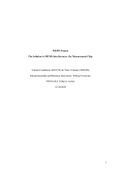MEMS Project
The Solution to MEMS Interferences: the Measurement Chip
Yannick Lankhorst (2052754) & Timo Verkade (2043899)
Entrepreneurship and Business Innovation, Tilburg University
300324-B-6: Eship in Action
12/20/2020
1
, Table of contents
Description of the project 3
Identifying trends, unmet customer needs and problems 5
Validating assumptions on the customers and their problems 7
Outcomes of the validation experiments 8
Identifying current solutions 10
Our solution 12
Carrying out a solution feasibility analysis 13
Final review: the trend, customer, problem and solution analysis 15
Reflections on the process and outcomes 17
Appendices 18
References 20
2
, MEMS Project
Description of the project
We (Yannick & Timo, group 86) got assigned to the following challenge:
“Gyroscopes are devices that help vehicles, drones, and wearable and handheld electronic
devices (e.g. smartphones) know their orientation in three-dimensional space. They are
commonplace in just about every bit of technology we rely on every day.
Microelectromechanical sensors (MEMS) measure changes in the forces acting on two
identical masses that are oscillating and moving in opposite directions. These sensors are
commonplace, but not without technical limitations. Magnetic fields may distort the sensors’
accuracy. The severity of such limitations may motivate the development of alternative
solutions. However, that solution should match (or beat) the other qualities of current
gyroscopes to be commercially viable.”
This means that magnetic interferences may distort the outcomes of MEMS chips.
MEMS chips (micro-electro-mechanical systems) can be found in a large variety of systems,
ranging across electronical, automotive, medical, communicational, semiconductors, defense,
aerospace, and way more. MEMS were developed out of necessity for smaller chips.
(TechTarget Contributors, 2019). Everything needs to be as small as possible since the end
products (in most cases) need to be as small as possible as well. Think of a smartphone,
where there is less space to fit a chip than there is in a car. This also reduces costs and, of
course, reduces the costs of electricity/energy. MEMS are made from components/parts
ranging from 1 to 100 micrometers in size (for reference, this is 0.001 to 0.1 mm). The
MEMS devices are typically 20 micrometres to a millimetre in size. (Wikipedia contributors,
3
, 2020)
Interpretation of the challenge:
The challenge is about Gyroscope and MEMS. These products have limitations. MEMS
experience interference from the outside, and as a result; they are not 100% accurate. The
challenge is to find a new solution for this limitation. There are probably a lot of solutions
already, but apparently none of them are adequate.
MEMS chips can be found in a wide variety of products (picture 1), such as:
Automotive industry, the MEMS chips/Gyroscopes in cars are for instance used in airbags.
The chips make sure that the airbag activates when you hit an object. The chips measure
acceleration or deceleration, and when the deceleration force hits a certain value the airbags
deploys. (Bosch, z.d.)
Medical industry, MEMS chips are used in hearing devices. MEMS made it possible to
make a small sized, sound-wise good quality and affordable hearing aid. (Goyal, 2017)
Aerospace, in aviation MEMS chips are used in devices to actively reduce drag, inertial
navigation and in health monitoring systems. Health monitoring is done for the passengers
safety. (“MEMS for Automotive and Aerospace Applications | ScienceDirect”, 2013)
MEMS chips have a lot more applications, you can find a MEMS chip in close to all
everyday technological products.
4





